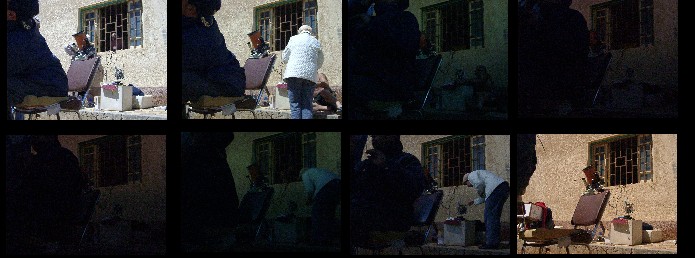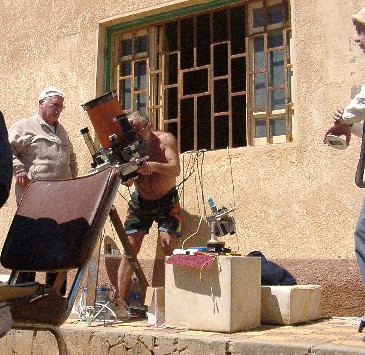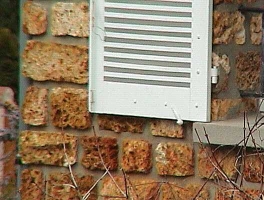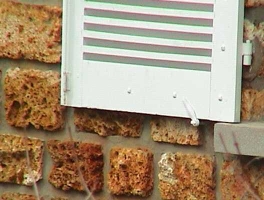
Total Solar Eclipse 2006
(3 min 58 s of darkness in El Sellum)
Unfortune of an eclipse chaser
... when all goes wrong !
When you see this nice image I took in Saloum, western Egypt (type "el sellum, egypt" in Google Earth find places), you may wonder of what I am talking about ?
In the next lines
you will learn what happened in details and hoppefully this will save you from a crual experience on a future eclipse tour !
Well I had in charge - with the help of S. Rochain - a difficult high resolution
(2 m focal length with an orange C8) scientific experiment (1)
about waves in the polar region of the corona and a more simple one about polarisation.
I had all the time needed to prepare myself for more than a week in Sidi Barany
at the TAMOIL Hotel with all the nice members of the french scientific team
associated with the IAP, Paris under the supervision
of S. Koutchmy. I had also brought some cameras and intruments to take some
pictures ...
A few days before totality I had a premonitory dream and woke up suddenly at
4 am with in mind the first page of "LE Monde" of the 29th of
Mars saying "All went wrong... bad preparation, too complicated !".
Then for the rest of the night I made changes in the protocols in order to have
only the solar filters to remove and put back during the eclipse. I thought
now the bad dream won't happen :) ... Well I did not know then that Murphy would
be all the time of the totality with me to spoil everything !
I had planned a nice program of automated captures with starting times far from totality in order not to disturb the main experiment on waves :

1) A Canon 10D (2 just for nice
shots !) with a 70-300mm lens + 1.4 tele-extender, working at 200 ISO and directed
via USB by the last version of DSLRFocus (specially written for the occasion)
on a portable PC. Starting time for auto mode was planned at 4 min before 2nd
contact. Exposures ran slowly from 1/4000s to 4s in the middle of the totality
and then back from 4s to 1/4000s (for Bailly's beads pics). This was fixed on
the mount of the C8. Before that time, during partial phase, pictures where
taken from time to time by clicking on the "take picture" button of
the program.
2) A sony DCR-PC 10 in afocal mode on a Coronado-PST (3)
(to see HAlpha during partial phases & totality) behind a 35mm eyepiece.
The Sun was visible on the screen in manual exposure mode (automatical mode
would give completely saturated images). Two one hour mini-DV where used : One
of them covering 30min before up to 30min after totality. This was fixed on
the other side of the mount of the C8, giving a rather good equilibrium.
3) A sony DCR-PC 10 on a Purus mecanically motorised mount in azimutal mode
(1 turn /24h) (4). [See B) paragraph
below] was aimed at 61.5° elevation. In front of the objective, a circular
polarizing filter could turn with the help of a small motor at a rate of 1 turn
in 56s. Hopefully it would turn 4 times during totality and give interesting
information on the corona. It was set on maximum manual luminosity and in manual
focus to infinity.
4) A Casio QV2900UX with a 128Mo flash card, was put on a small tripod on the ground, at 5 meter of the C8, aiming at the wall of the weather station where we were working, in order to catch flying shadows and the evolution of the ambiant luminosity. It was started long before 1st contact in automatic time lapse mode1 shot per min with the possibility to take about 150 JPG pictures at full 2.1Mpix resolution (below images around and during the 4 min eclipse).

5) Last, I had a small Aiptek video camera with a 64Mo SD card, giving 15 min of automatic recording and auto saving at end of memory space. It was put on a pole on the roof of the weather station, aiming in the direction of the coming eclipse shadow and would be started 5 min before totality by a Bernard also working on the roof then turned by him in the opposite direction to follow the shadow going away after the middle of totality.
Miscelleanous :
All apparatus had been synchronised with a DCF clock with a PC parallel port and software (PC Funkgesteuerte uhr, very accuratly synchronised by radio at the time of departure from Paris) in the morning. Then I took the battery out and back in but could not get any new synchronisation with Franckfurt, 1800 km away... It was mesured when returning back in France that its time was at most .7s off during the eclipse. For this purpose, the Sony camcorder was aimed at the unsynchronized DCF clock used in Egypt and another one synchronized in Paris. Counting the number of frames for 1s and the offset of the 2 clocks in frames gaves the former result.
The responsability to take off the filter was divided on 3 persons
(Helene, Serge and myself).
Portable phones put on sheets of paper with reason of the ringing were planned
to ring at 2 min before 1st contact, 5 min before totality and 1 min before
end of totality. Later one of them was set to 2 min before last contact.

The start of the problems occured long before the totality, at the moment of the first contact. I was working on the C8. We had time and it was interesting to record the time of the contact with great accuracy. Me and others around agreed on where the Moon would start "eating" the Sun in the C8 firld. But a min after 1st contact I had nothing in view ! I decided to go around the Sun and found the Moon in the opposite direction. Probably from then I was slightly shaken ... Otherwise I would have used this first error in a better way as it will be discussed later ...
The wave experiment
The C8 was equipped with a binocular head and 2 Atik 2 cameras, one with a green filter + IRCut filter and the other with a red R25 filter. The head had to be oriented at 26° from the horizontal to be at the solar pole. Astrosnap Pro (special beta version made for this experiment) would record the two 640*480 signals from the cameras, in the same session of the program and save an AVI, with frames side by side in one large 1280*480 format. Focusing the two cameras was no particular problem especially with the sunspots present that day. Orientation of the camera was also rather simple using the alternate mode to have the two limbs parralel on the PC screen.
There was a problem with the C8 modified mount (in order not to need any counterweights for this really particular eclipse, a quarter an hour after meridian) : when using the DEC towards high values, the system was getting to tight and not functioning. We had to go upwards manually more than necessary then use the paddle to go down.
When totality approched, we were unable to decide for sure where the south pole was ! Plans were too work at that level... We tried to used the "push on the front top of the telescope" approach to aim more to the south but on the PC screen the movement was more than less sideways (cause by the 26° orientation of the binocular head) ! We also could not decide if the orientation of 26° was to the right or to the left ... We were getting very nervous !
To be continued...
A Solar Eclipse preparation
A) Protection is the most important factor !
During the totality (meaning during the few moments
of darkness when the Moon occults completely the disk of the Sun) looking at
the Sun without visual protections in no way dangerous and an unforgetable sight
! There is nothing as special harming
eclipse rays !!
On the contrary before and after those few moments, looking at the
Sun without the special protections - as sold in astronomy shops only - is as
dangerous for your eyes as looking at noon at the Sun any other day of the year
! If you have kept protections from another previous eclipse, beware that the
filters are in mint condition otherwise just throw them away and buy new ones
!
I suggest that you do yours observations after participating to an astronomy club to be told more safety hints !
| SAFE FILTERS* SN14 Welder's Filter / Solar Skreen / Baader Astrosolar film (visual) / Thousand Oaks T2 glass or Black Polymer / Fully exposed & fully developed Plus X negative |
| UNSAFE FILTERS * E xposed & fully developed color negative film (all the infra-red passing through to burn your eyes !) and others. |
| *From article of F. Espenak, NASA http://sunearth.gsfc.nasa.gov/eclipse/SEpubs/TP212762b.pdf |
B) If you travel by plane, weight is a main factor. (Important correction 20060312)
As the totality will happen at about 15min after the Sun transit
the meridian, the movement of the Sun in DEC will be less than 10' during the
totality. One may then keep only the RA part of an equatorial mount with some
adjustable fixation to the good angle to follow the Sun.
BUT if you want to use a simple horizontal support with a motor and a plate
at 60° then its speed needs to be
2
turns per day ... twice the sideral speed !
because of the high zenithal position of the Sun (~60°) !
Otherwise (1 turn per day) the
Sun will seem to move at sideral speed (which is acceptable for a totality of
5 min if you have a FOV of about 8 solar diameter and put the image of the Sun
at the right place at the beginning) or if you are able to watch and correct
manually from time to time !
The formula is : sin A . sin Z =
cos D . sin H
A = azimut , Z zenithal distance = angle from zenith, D declinaison of object,
H angle hour
In our case :
D (29 march) ~=0 -> cosD ~=1
Z = 30° (elevation of the Sun = 60°) -> sin Z = 0.5
Conclusion sin A = 2 sin H !
C) Canon 10D, 300D - FOV (field of vue)
.jpg) |
.jpg) |
Above the FOV is about 7 Sun diameters. It is obtained
with a Canon 10D + 75-300mm 1:4-5.6 EF Canon Telephoto lens at (max) 300mm
and a 1.4x tele-extender (+ of course solar filter).
The Sun is bit too small but quality is as good as possible ! |
Simulation at 300mm + 2x tele extender.
It is a bit too large FOV. With a little more than 4 diameters of the
Sun it may just be not enough to have all the extents of the corona during
minimal activity as now. |
.jpg) |
Using a 2x tele extender with a 5.6 lens is not recommended as quality may be less acceptable - too much softer - than with 1.4x tele extender. A 2x tele extender would be a much better idea |
Simulation at 250mm + 2x focal extender. With 5 diameters of the Sun it is probably the best fit to get all the extents of the corona using long exposures. |
D) Sony DCR PC 110e Camcorder (FOV & movements)
 |
 |
| FOV optical zoom maxi (equiv. 480mm) | FOV optical zoom maxi + Casio 1.5 tele extender with 37->43mm step up ring (equiv. 710mm) |
FOV optical zoom maxi (equiv. 480mm) on real Sun with appropriate Sun filter. On the right bottom a Sun image at the size of the 640*480 original video is glued. Note than manual luminosity control is a must here or during the partial eclipse phases but not during the totality itself ! click on image to watch a 5 min. wmv movie (1.2Mb) showing the Sun near meridian moving in real time very slowly at this magnification. To see it better, put the mouse just at the south pole of the Sun at the beginning of the movie...You may even not really nead a motorised mount, if you recenter the disk every 30s or so. |
FOV optical zoom maxi + Casio 1.5 tele extender with 37->43mm step up ring (equiv. 720mm) on real Sun with appropriate Sun filter. On the right bottom a Sun image at the size of the 640*480 original video is glued. click on image to watch a 1 min. wmv movie (300Kb) showing the Sun near meridian moving in real time rather slowly at this magnification. To see it better, put the mouse just at the south pole of the Sun at the beginning of the movie... You may even not really nead a motorised mount, if you recenter the disk every 20s or so. |
E) Most visible planets and stars
East of the Sun you will see Rigel, North East Mars and Capella, West see first Mercury then bright Venus and below them Fomalhaut and to the North West the star Vega.